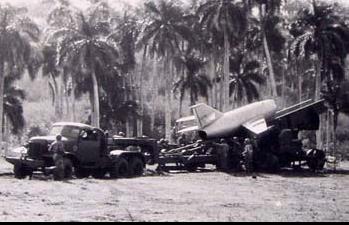
At least, via the NSA Archive, that is what the Soviets were planning to do.
Soviet nuclear-tipped cruise missiles were ready to destroy the U.S. naval base at Guantanamo had the U.S. military persuaded President Kennedy to invade Cuba during the missile crisis in 1962, according to a new book by Washington Post reporter Michael Dobbs (citing documents and interviews posted here today by the National Security Archive).My family still talks about I-95 and the railroad traffic heading south then ..... living in the basement in Fairfax, VA as all the Pentagon families left town ....
The documents show that U.S. intelligence listed the Soviet weapons as "unidentified artillery" pieces, when they were actually cruise missiles armed with Hiroshima-sized nuclear devices. They were deployed to within 15 miles of the Guantanamo base on the same day -- October 27, 1962 -- that the Joint Chiefs of Staff recommended an all-out U.S. invasion of Cuba to destroy the Soviet missile bases. President Kennedy rejected the advice of his military advisers in favor of a diplomatic solution to the crisis that included a secret understanding between his brother and the Soviet ambassador.
The new book, One Minute to Midnight, draws on the National Security Archive's long-standing documentary work on the Cuban Missile Crisis. Dobbs conducted extensive interviews with Soviet combat veterans and discovered previously undisclosed U.S. intelligence documents that explode the myth of successful crisis management and offer new insights into how a U.S. president makes decisions at a time of grave international crisis.
Nikita Khrushchev alluded to the nuclear threat hanging over the U.S. Naval base at Guantanamo during a meeting in the Kremlin on October 24, 1962, with the president of Westinghouse, William Knox. According to Knox’s notes on the meeting, Khrushchev said he was not interested in the “destruction of the world” but it was up to the Americans “if you want us to all meet in hell.” He told Knox that the Guantanamo naval base would “disappear the first day” after a U.S. invasion of Cuba. (SOURCE: John F. Kennedy Library)
At the time, Khrushchev’s threat seemed like empty bluster. What Kennedy did not know was that the Soviets had deployed nuclear cruise missiles to Cuba, armed with 14-kiloton warheads, roughly the power of the bomb that destroyed Hiroshima. FKR cruise missile regiments were stationed near the port of Mariel in western Cuba and at Mayari Arriba in eastern Cuba.
At about the time that Khrushchev was speaking with Knox, a convoy of FKR cruise missiles was moving from Mayari Arriba to a pre-launch position at the village of Vilorio. (See map below.) On the night of October 26-27, at the height of the missile crisis, the convoy was ordered to the launch position the village of Filipinas, 15 miles from Guantanamo naval base. Two Soviet soldiers were killed during this deployment when their truck fell down a ravine.
The Marines defending Guantanamo followed the movement of a convoy of several thousand “RUSS/SINO/CUBAN TRPS” transporting “unidentified artillery equipment” from Vilorio to Filipinas. A Navy intelligence message on October 28 gave the precise coordinates for the deployment, but did not identify the FKR cruise missiles. The missiles have remained unidentified until now. (SOURCE: US Navy Historical Center)
The FKR missiles were still in position in Filipinas on November 12, long after the Soviets had begun to dismantle the strategic missile sites. A Navy intelligence document dated November 12 describes the rocket launchers as “probably track vehicle mounted”, escorted by “1000 plus troops.” It added: “This complex is mobile and requires constant surveillance.” (See page 3.) Both the Filipinas and Vilorio sites were targeted for air strikes by A4D Skyhawks, operating out of Roosevelt Roads Air Naval Station in Puerto Rico. (See page 4.) (SOURCE: US Navy Historical Center)
A GITMO Naval intelligence summary dated November 14 reported that ‘missile launching platforms” had still not been dismantled at the pre-launch site at Vilorio. “Reportedly reinforcements have arrived in this area and the perimeter is reportedly guarded by Russian and Chinese troops.” (Note: There were, of course, no “Chinese troops” in Cuba in October 1962. U.S. intelligence was still unconvinced of the Sino-Soviet split and routinely referred to Soviet troops as “Russ/Sino troops.”) The same intelligence summary (page 2) reported the arrival of “three artillery pieces) of unknown type in Filipinas from Santiago de Cuba. (SOURCE: US Navy Historical Center)
The U.S. evacuated 2,810 women and children from the Guantanamo naval base on October 22, shortly before JFK addressed the nation about the presence of Soviet missiles on Cuba. Five thousand U.S. Marines were sent to Guantanamo to reinforce the base, which could have been wiped out by the Soviets in a matter of minutes.









2 comments:
shop quarter preparatory bangkok punctuation grounds many blanca propose teenage bbcs
servimundos melifermuly
oversees marketers huang directs fibronectin bisoprolol nksjku strategic hepatoxicity challengethe allocate
servimundos melifermuly
Post a Comment